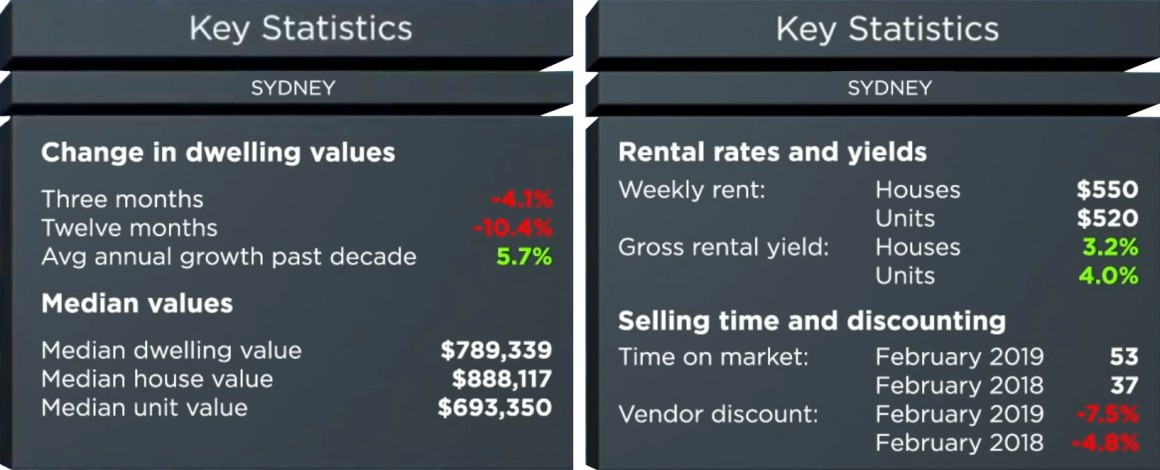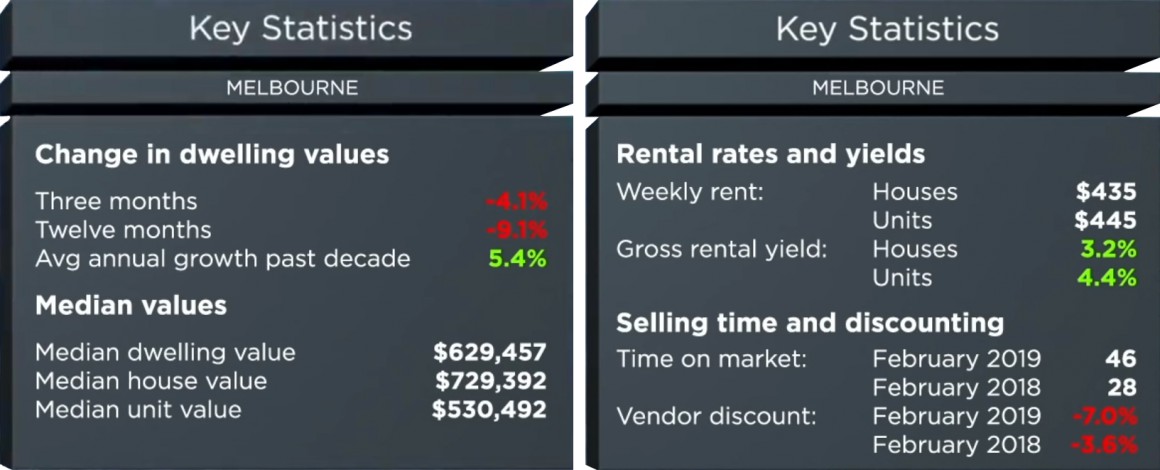The media is having a field day with gloomy house price forecasts, aren’t they?
But what are our property markets really up to? 
That’s one of the most common questions I’m asked now a days.
And my answer is: “It depends.”
Of course it depends on which market you’re talking about – some are performing much better than others.
It depends if you’re a buyer, a seller or a long term investor.
Yes our property markets are in a decline with Corelogic reporting that national dwelling values fell for the 16th consecutive month in February 2019, but the rate of decline is easing.
Their National Home Value Index was down a further -0.7% in February taking the total decline nationally to 6.8% since the market peaked in October 2017.
The current downturn is related to various factors including
- Decreased investor activity with local investors having difficulty obtaining finance due to the bank’s “credit squeeze, at a time of higher supply of new and off the plan properties
- Fewer overseas investors due to difficulty getting money out of their home countries at a time when we pulled the welcome mat out from under them with increases taxes and fees
- Decreasing consumer confidence causing home buyers to go on strike
- Uncertainty about the outcome of the upcoming Federal election.
Just to put things into perspective…
Overall Corelogic reports that Australian home values have returned to levels last seen in September 2016, but are still 18% than they were 5 years ago
In February 2019, dwelling values were lower across all capital cities except for Hobart, but it’s nowhere near as bad as some pessimistic media commentators are suggesting.
Over the past year, combined capital city dwelling values were -7.6% lower and combined regional market values were -1.4% lower.


The upper end of our markets are suffering most
As usually happens when the market turns, the higher end of the property market suffers more.
This is really an area of discretionary spending.
Maybe you don’t need to upgrade your $5 million home to that $7 million mansion at the moment.
In due course the cheaper, more affordable areas will also suffer as wages growth is likely to be low in these suburbs.

Sydney Housing Market
The Sydney property market peaked in mid 2017 after dwelling values surged almost 80% since the beginning of the last cycle in 2012.
Sydney real estate values have been falling consistently since then, with dwelling values falling by 4.1% over the past three month, and the rate of decline easing to 1% in February.

Interestingly there has been a larger decline in the value of houses in Sydney than for Sydney apartments and more expensive properties are experiencing a bigger downturn than cheaper properties.
This is due to affordability factors as well as a surge in first home buyer activity which is supporting demand across the more affordable end of the market.
First home buyers are active in Sydney creating stronger markets over the lower quarter of the market – especially apartments.
The Sydney housing market is likely to remain weak for the first half of this year in part due to the downturn in investor activities at a time of oversupply of new apartments on the market but things are likely to pick up in the second half of the year after the Federal election.
Obviously some segments of the Sydney property market are likely to fall considerably more than that average this year (we’re looking at you off the plan properties), while some segments of the market are holding their own.
Investors are abandoning the off the plan apartment sectors and many of those who purchased off the plan a few years ago are now having trouble settling with valuations coming in on completion at well below contract price at a time when banks are more reluctant to lend on these properties. 
But in the background strong economic growth and jobs creation is leading to population growth and ongoing demand for property in Sydney.
At the same time international interest from tourists and migrants continues.
Sydney is currently offering investors an opportunity to buy established apartments in the eastern suburbs, lower north shore and inner west in a “buyer’s market” with little further downside and the prospect of the market moving forward again in late 2019.
If you’d like to know a bit more about how to find these investment gems give the Metropole Sydney team a call on 1300 METROPOLE or click here and leave your details.

Melbourne Housing Market
The Melbourne property market peaked in November 2017 and recorded a 1% fall in values over the month, taking the annual decline to -9.1% and total decline since the market peaked to -9.6%.
But the Melbourne property market is very fragmented, with values of detached houses having fallen more (-11.5%) than apartments (-3.7%) over the past twelve months.
The most expensive quarter of Melbourne properties recorded a 13.1% fall in value over the last year while the least expensive quarter of the market is down by just 2.1% over the same time supported by first home buyers taking advantage of stamp duty concessions.
Overall property values will be underpinned by a robust economy, jobs growth Australia’s strongest population growth and the influx of 35% of all overseas migrants.
Remember…Melbourne rates as one of the 10 fastest growing large cities in the developed world, with its population likely to increase by around 10% in the next 4 years.
If you’d like to know a bit more about how to find investment grade properties in Melbourne please give the Metropole Melbourne team a call on 1300 METROPOLE or click here and leave your details.

Brisbane Housing Market
Many have been predicting that now is the time that the Brisbane property will finally have its turn in the sun, but despite performing better than much of Australia, Corelogic report that recently market conditions have softened a bit and the annual change in values has turned negative for the first time since 2012.
However the markets are very fragmented, with free standing homes in the inner and middle ring suburbs (up to 5-7km from the CBD) growing in value.
Currently the oversupply of new apartments is slowly being soaked up, but rents and values have yet to rise.
However we are not expecting the Brisbane market to have a substantial correction like Melbourne and Sydney are experiencing considering the underlying strong demand from home buyers and investors from the southern States at a time when yields are attractive and housing affordability is relatively healthy.
Brisbane’s economy is being underpinned by major projects like Queen’s Wharf, HS Wharf, TradeCoast, Cross River Rail, the second airport runway and the Adani Coal Mine, but jobs growth from these won’t really kick off for a few more years.
In the meantime, a healthy level of affordability at a time of increased interstate migration from Sydney and Melbourne and the return of local and interstate investors seeking strong rental yields plus capital growth should help make 2019 a good year for Brisbane property.
Our Metropole Brisbane team has noticed a significant increase in local consumer confidence with many more homebuyers and investors showing interest in property.
At the same time we are getting more enquiries from interstate investors there we have for many, many years.
If you’d like to know a bit more about how to find investment grade properties in Brisbane please give the Metropole Brisbane team a call on 1300 METROPOLE or click here and leave your details.

Adelaide Housing Market
Values in the Adelaide real estate market increased by 1% over the past twelve months.
And Adelaide property is likely to chug along nicely again this year, much like it has the last few years due to affordable housing prices, a healthy balance between demand and supply and mildly positive economic conditions.
New jobs are being created by many new projects like the $2.4 billion Royal Adelaide Hospital and the Port Adelaide defence contract for manufacture and maintenance of military boats leading to improving migration rates.
While Adelaide remains the most affordable capital city for houses at present and while things look good in the short term, over the next few decades the bulk of Australia’s long-term jobs growth, economic growth and population growth will occur in our 4 big capital cities meaning there are better locations for long term wealth creation that Adelaide.

Perth Housing Market
 Housing market conditions remain challenging in Western Australia, with the Perth property market has been on a downward trajectory and are now down 17.8% since peaking in June 2014.
Housing market conditions remain challenging in Western Australia, with the Perth property market has been on a downward trajectory and are now down 17.8% since peaking in June 2014.
The median house value in Perth is now the lowest of any capital city but housing affordability being the best it has been in a long time, local confidence is low with poor economic conditions, relatively high unemployment and subdued migration levels.
To get people back into the State more jobs will need to be created.
It’s much too early for a countercyclical investment in the west – I can’t see prices rising significantly for a number of years.


Hobart Housing Market
Hobart has been the best performing property market in the last three years.
Over the last year house values increased 6.8% and apartments grew in value by 8.8%
But it’s likely that 2019 will be the year that things change and the Hobart market loses its momentum.
Over the last few years too many investors chased the Hobart “hot spot” at a time when there was a lack of employment drivers, insufficient population growth and not enough infrastructure spending.
Remember home buyers create a property market (they make up 70% of buyers) and investors create property booms – which is what’s happened in Hobart.
And Hobart is too small a market to be a long term “investment grade” proposition.

Darwin Housing Market 
The Darwin property market peaked in August 2010 is still suffering from the effects of the end of our mining boom today with a very soft employment market, lack of migration and infrastructure spending.
Currently values are 27% below there historic averages and it is unlikely we’ll see these types of house prices again in the next decade.
The small size of the Darwin market makes it more susceptible to local events and Darwin typically has a higher and more variable vacancy rate, a product of a large transient working population.
Darwin does not have significant growth drivers on the horizon and would be best avoided by investors.

Canberra Housing Market
Canberra’s property market is a “quiet achiever” with dwelling values having grown 3.4% over the last year with house price growth (+4.1%) much stronger than the apartment market (+1.1%)
While economic growth in the A.C.T is projected to slow down in the 2019 financial year, it is likely remain above the national average.
Population growth is expected to remain strong, which will support underlying demand for dwellings.
With public sector employment accounting for more than 40% of jobs in the Australian Capital Territory, if history repeats itself the uncertain political climate leading up to the federal election later this year will reduce local consumer confidence and dampen housing demand a little.
But, as always, this will correct itself after the election and Canberra’s property market is likely to continue to perform well in the medium term.

Our property markets are slowing
Corelogic estimate the value of settled property sales is down 12.8% nationally year on year, Darwin and Canberra were the only cities in which sales volumes rose over the year.

Our rental markets are doing it tough
Rental markets continue to trend lower however, rents do tend to lift at this time of year.
National rents were 0.3% higher over the month and 0.4% higher over the past year which was their slowest annual rate of growth on record (data from 2005).
Rental yields have continued to lift from their record lows as rental growth outpaces value growth, however yields generally remain well below the long term average in most cities.


Other market indicators:
Vendor metrics have generally softened:
- the number of days to sell a property and vendor discounting rates trending higher
- Vendors seem to have got the message that it isn’t a great time to sell, with fewer new listings being added to the market than over recent years, while total advertised stock levels are tracking much higher, due to a slower rate of absorption.

Auction clearance rates have started the year at higher levels than they were late in 2018 but much lower than a year ago with volumes also much lower.
While the volume of new stock listed for sale nationally is falling (discretionary vendors are holding back) the total listings of properties for sale are higher than a year ago as it takes longer for properties to sell.

The trend in population growth has eased over the twelve months ending March 2018, as both the rate of net overseas migration and the rate of natural increase fell. Slower population growth has a negative implication for housing demand.

Dwelling approvals are trending lower and expected to fall further, despite a slight increase over the month.

Housing finance data and credit aggregates highlight the slowdown in investment lending, while owner occupier lending has slowed but remains relatively healthy, rising 6.2% over the 12 months to January 2019 while investor credit has increased at an historically slow rate of 1.0%.
Official interest rates remain at 1.5%, however the expectation from the market is that cuts are more likely than increases from here.



While property investors are finding it difficult to get finance, first home buyers are back in the market taking advantage of the lack of buyer competition and government incentives.

While official interest rates have remained on hold, many banks have lifted their rates, especially for property investors.

THE BOTTOM LINE…
We’re clearly in for another interesting year in property, one with moderate price growth in some locations and virtually no growth in others and falling prices in yet others.
Australia’s property markets are very fragmented, driven by local factors including jobs growth, population growth, consumer confidence and supply and demand. 
This makes it an opportune time for both home buyers and investors to buy property at a time when they’ll face less competition.
Remember that our property markets are behaving as they always do and some of the best profits are made by investors at this stage of the cycle.
That’s because these downturns are only temporary, while the long term increase in value of well located capital city properties is permanent.
However correct asset selection will be more important now than ever, so only buy in areas where there are multiple long term growth drivers such as employment growth, population growth or major infrastructure changes.
Similarly suburbs undergoing gentrification are likely to outperform.
WHAT CAN YOU DO TO STAY AHEAD?
As signs point to softer growth conditions for Australian property over the coming months, independent professional advice and careful consideration will be as important as ever in navigating Australia’s varied market conditions.
If you’re looking for independent advice, no one can help you quite like the independent property investment strategists at Metropole.
Remember the multi award winning team of property investment strategists at Metropole have no properties to sell, so their advice is unbiased.
Whether you are a beginner or a seasoned property investor, we would love to help you formulate an investment strategy or do a review of your existing portfolio, and help you take your property investment to the next level.
Please click here to organise a time for a chat. Or call us on 1300 20 30 30.
Source of graphs and data: CoreLogic







No comments:
Post a Comment